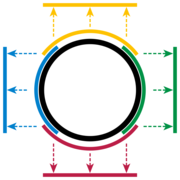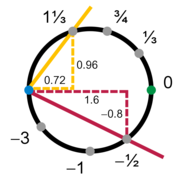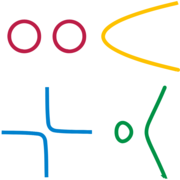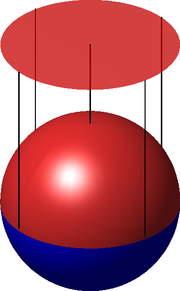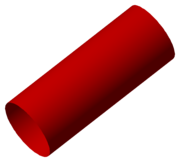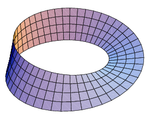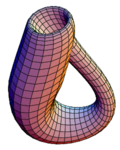Manifold
2007 Schools Wikipedia Selection. Related subjects: Mathematics

A manifold is an abstract mathematical space in which every point has a neighbourhood which resembles Euclidean space, but in which the global structure may be more complicated. In discussing manifolds, the idea of dimension is important. For example, lines are one-dimensional, and planes two-dimensional.
In a one-dimensional manifold (or one-manifold), every point has a neighbourhood that looks like a segment of a line. Examples of one-manifolds include a line, a circle, and two separate circles. In a two-manifold, every point has a neighbourhood that looks like a disk. Examples include a plane, the surface of a sphere, and the surface of a torus.
Manifolds are important objects in mathematics and physics because they allow more complicated structures to be expressed and understood in terms of the relatively well-understood properties of simpler spaces.
Additional structures are often defined on manifolds. Examples of manifolds with additional structure include differentiable manifolds on which one can do calculus, Riemannian manifolds on which distances and angles can be defined, symplectic manifolds which serve as the phase space in classical mechanics, and the four-dimensional pseudo-Riemannian manifolds which model space-time in general relativity.
A technical mathematical definition of a manifold is given below. To fully understand the mathematics behind manifolds, it is necessary to know elementary concepts regarding sets and functions, and helpful to have a working knowledge of calculus and topology.
Motivational examples
Circle
The circle is the simplest example of a topological manifold after a line. Topology ignores bending, so a small piece of a circle is exactly the same as a small piece of a line. Consider, for instance, the top half of the unit circle, x2 + y2 = 1, where the y-coordinate is positive (indicated by the yellow arc in Figure 1). Any point of this semicircle can be uniquely described by its x-coordinate. So, by projecting onto the first coordinate, one obtains a continuous mapping between the semicircle and the open interval (−1, 1):
Such a function is called a chart. Similarly, there are charts for the bottom (red), left (blue), and right (green) parts of the circle. Together, these parts cover the whole circle and the four charts form an atlas for the circle.
The top and right charts overlap: their intersection lies in the quarter of the circle where both the x- and the y-coordinates are positive. The two charts χtop and χright each map this part bijectively to the interval (0, 1). Thus a function T from (0, 1) to itself can be constructed, which first inverts the yellow chart to reach the circle and then follows the green chart back to the interval. Let a be any number in (0, 1), then:
Such a function is called a transition map.
The top, bottom, left, and right charts show that the circle is a manifold, but they do not form the only possible atlas. Charts need not be geometric projections, and the number of charts is a matter of some choice. Consider the charts
and
Here s is the slope of the line through the point at coordinates (x,y) and the fixed pivot point (−1,0); t is the mirror image, with pivot point (+1,0). The inverse mapping from s to (x,y) is given by
it can easily be confirmed that x2+y2 = 1 for all values of the slope s. These two charts provide a second atlas for the circle, with
Each chart omits a single point, either (−1,0) for s or (+1,0) for t, so neither chart alone is sufficient to cover the whole circle. It is not possible to cover the full circle with a single chart, since the circle is doubly connected and the line is only simply connected. Note that it is possible to construct a circle by "gluing" together a single piece of the line; this does not produce a chart, since a portion of the circle will be mapped to both "glued" regions at once.
Other curves
Manifolds need not be connected (all in "one piece"); thus a pair of separate circles is also a manifold. They need not be closed; thus a line segment without its ends is a manifold. And they need not be finite; thus a parabola is a manifold. Putting these freedoms together, two other example manifolds are a hyperbola (two open, infinite pieces) and the locus of points on the cubic curve y2 = x3−x (a closed loop piece and an open, infinite piece).
However, we exclude examples like two touching circles that share a point to form a figure-8; at the shared point we cannot create a satisfactory chart. Even with the bending allowed by topology, the vicinity of the shared point looks like a "+", not a line.
Enriched circle
Viewed using calculus, the circle transition function T is simply a function between open intervals, which gives a meaning to the statement that T is differentiable. The transition map T, and all the others, are differentiable on (0, 1); therefore, with this atlas the circle is a differentiable manifold. It is also smooth and analytic because the transition functions have these properties as well.
Other circle properties allow it to meet the requirements of more specialized types of manifold. For example, the circle has a notion of distance between two points, the arc-length between the points; hence it is a Riemannian manifold.
History
The study of manifolds combines many important areas of mathematics: it generalizes concepts such as curves and surfaces as well as ideas from linear algebra and topology. Certain special classes of manifolds also have additional algebraic structure; they may behave like groups, for instance.
Prehistory
Before the modern concept of a manifold there were several important results.
Carl Friedrich Gauss may have been the first to consider abstract spaces as mathematical objects in their own right. His theorema egregium gives a method for computing the curvature of a surface without considering the ambient space in which the surface lies. Such a surface would, in modern terminology, be called a manifold; and in modern terms, the theorem proved that the curvature of the surface is an intrinsic property. Manifold theory has come to focus exclusively on these intrinsic properties (or invariants), while largely ignoring the extrinsic properties of the ambient space.
Another, more topological example of an intrinsic property of a manifold is the Euler characteristic. For a non-intersecting graph in Euclidean 2-dimensional space, with V vertices (or corners), E edges and F faces (counting the exterior) Euler showed that V-E+F= 2. Thus 2 is called the Euler characteristic of Euclidean 2-dimensional space. By contrast, the Euler characteristic of the torus is 0, since the complete graph on seven points can be embedded into the torus. The Euler characteristic of other 2-dimensional spaces is a useful topological invariant, which can be extended to higher dimensions using Betti numbers.
Non-Euclidean geometry considers spaces where Euclid's parallel postulate fails. Saccheri first studied them in 1733. Lobachevsky, Bolyai, and Riemann developed them 100 years later. Their research uncovered two types of spaces whose geometric structures differ from that of classical Euclidean space; these gave rise to hyperbolic geometry and elliptic geometry. In the modern theory of manifolds, these notions correspond to manifolds with constant negative and positive curvature, respectively.
Synthesis
Bernhard Riemann was the first to do extensive work generalizing the idea of a surface to higher dimensions. The name manifold comes from Riemann's original German term, Mannigfaltigkeit, which William Kingdon Clifford translated as "manifoldness". In his Göttingen inaugural lecture, Riemann described the set of all possible values of a variable with certain constraints as a Mannigfaltigkeit, because the variable can have many values. He distinguishes between stetige Mannigfaltigkeit and diskrete Mannigfaltigkeit (continuous manifoldness and discontinuous manifoldness), depending on whether the value changes continuously or not. As continuous examples, Riemann refers to not only colors and the locations of objects in space, but also the possible shapes of a spatial figure. Using induction, Riemann constructs an n-fach ausgedehnte Mannigfaltigkeit (n times extended manifoldness or n-dimensional manifoldness) as a continuous stack of (n−1) dimensional manifoldnesses. Riemann's intuitive notion of a Mannigfaltigkeit evolved into what is today formalized as a manifold. Riemannian manifolds and Riemann surfaces are named after Bernhard Riemann.
In the study of complex variables, the process of analytic continuation leads to the construction of manifolds.
Abelian varieties were already implicitly known in Riemann's time as complex manifolds. Lagrangian mechanics and Hamiltonian mechanics, when considered geometrically, are also naturally manifold theories. All these use the notion of several characteristic axes or dimensions (known as generalized coordinates in the latter two cases), but these dimensions do not lie along the physical dimensions of width, height, and breadth.
Henri Poincaré studied three-dimensional manifolds and raised a question, today known as the Poincaré conjecture. As of 2006, a consensus among experts is that recent work by Grigori Perelman may have answered this question, after nearly a century of effort by many mathematicians.
Hermann Weyl gave an intrinsic definition for differentiable manifolds in 1912. During the 1930s Hassler Whitney and others clarified the foundational aspects of the subject, and thus intuitions dating back to the latter half of the 19th century became precise, and developed through differential geometry and Lie group theory.
Mathematical definition
In topology, an n-manifold is a second countable Hausdorff space in which every point has a neighbourhood homeomorphic to an open Euclidean n-ball,
Unless otherwise stated, a manifold is an n-manifold for some positive integer n, perhaps with additional structure. However, some authors admit manifolds which are not n-manifolds, in the sense that they allow different connected components to have different topological dimension.
The second countable condition excludes spaces such as the long line. The Hausdorff condition avoids spaces such as the one formed by identifying two real lines at every point except the origin:
- R × {a} and R × {b}
with the equivalence relation
 if
if 
which has a single point for each nonzero real number r plus two points 0a and 0b. In this space all neighbourhoods of 0a intersect all neighbourhoods of 0b.
There are many different kinds of manifold. All manifolds are topological manifolds, which locally have the topology of some Euclidean space. If there is additional structure, the structure on each map must be consistent with the overlapping maps. Differentiable manifolds have homeomorphisms on overlapping neighborhoods diffeomorphic with each other, so that the manifold has a well-defined set of functions which are differentiable in each neighbourhood, and so differentiable on the manifold as a whole.
Charts, atlases, and transition maps
The spherical Earth is navigated using flat maps or charts, collected in an atlas. Similarly, a differentiable manifold can be described using mathematical maps, called coordinate charts, collected in a mathematical atlas. It is not generally possible to describe a manifold with just one chart, because the global structure of the manifold is different from the simple structure of the charts. For example, no single flat map can properly represent the entire Earth. When a manifold is constructed from multiple overlapping charts, the regions where they overlap carry information essential to understanding the global structure.
Charts
A coordinate map, a coordinate chart, or simply a chart, of a manifold is an invertible map between a subset of the manifold and a simple space such that both the map and its inverse preserve the desired structure. For a topological manifold, the simple space is some Euclidean space Rn and interest focuses on the topological structure. This structure is preserved by homeomorphisms, invertible maps that are continuous in both directions.
In the case of a differentiable manifold, a set of charts called an atlas allows us to do calculus on manifolds. Polar coordinates, for example, form a chart for the plane R² minus the positive x-axis and the origin. Another example of a chart is the map χtop mentioned in the section above, a chart for the circle.
Atlases
The description of most manifolds requires more than one chart (a single chart is adequate for only the simplest manifolds). A specific collection of charts which covers a manifold is called an atlas. An atlas is not unique as all manifolds can be covered multiple ways using different combinations of charts.
The atlas containing all possible charts consistent with a given atlas is called the maximal atlas. Unlike an ordinary atlas, the maximal atlas of a given atlas is unique. Though it is useful for definitions, it is a very abstract object and not used directly (e.g. in calculations).
Transition maps
Charts in an atlas may overlap and a single point of a manifold may be represented in several charts. If two charts overlap, parts of them represent the same region of the manifold, just as a map of Europe and a map of Asia may both contain Moscow. Given two overlapping charts, a transition function can be defined which goes from an open ball in Rn to the manifold and then back to another (or perhaps the same) open ball in Rn. The resultant map, like the map T in the circle example above, is called a change of coordinates, a coordinate transformation, a transition function, or a transition map.
Additional structure
An atlas can also be used to define additional structure on the manifold. The structure is first defined on each chart separately. If all the transition maps are compatible with this structure, the structure transfers to the manifold.
This is the standard way differentiable manifolds are defined. If the transition functions of an atlas for a topological manifold preserve the natural differential structure of Rn (that is, if they are diffeomorphisms), the differential structure transfers to the manifold and turns it into a differentiable manifold.
In general the structure on the manifold depends on the atlas, but sometimes different atlases give rise to the same structure. Such atlases are called compatible.
Construction
A single manifold can be constructed in different ways, each stressing a different aspect of the manifold, thereby leading to a slightly different viewpoint.
Charts
Perhaps the simplest way to construct a manifold is the one used in the example above of the circle. First, a subset of R² is identified, and then an atlas covering this subset is constructed. The concept of manifold grew historically from constructions like this. Here is another example, applying this method to the construction of a sphere:
Sphere with charts
A sphere can be treated in almost the same way as the circle. In mathematics a sphere is just the surface (not the solid interior), which can be defined as a subset of R³:
The sphere is two-dimensional, so each chart will map part of the sphere to an open subset of R2. Consider the northern hemisphere, which is the part with positive z coordinate (coloured red in the picture on the right). The function χ defined by
- χ(x,y,z) = (x,y),
maps the northern hemisphere to the open unit disc by projecting it on the (x, y) plane. A similar chart exists for the southern hemisphere. Together with two charts projecting on the (x, z) plane and two charts projecting on the (y, z) plane, an atlas of six charts is obtained which covers the entire sphere.
This can be easily generalized to higher-dimensional spheres.
Patchwork
A manifold can be constructed by gluing together pieces in a consistent manner, making them into overlapping charts. This construction is possible for any manifold and hence it is often used as a characterisation, especially for differentiable and Riemannian manifolds. It focuses on an atlas, as the patches naturally provide charts, and since there is no exterior space involved it leads to an intrinsic view of the manifold.
The manifold is constructed by specifying an atlas, which is itself defined by transition maps. A point of the manifold is therefore an equivalence class of points which are mapped to each other by transition maps. Charts map equivalence classes to points of a single patch. There are usually strong demands on the consistency of the transition maps. For topological manifolds they are required to be homeomorphisms; if they are also diffeomorphisms, the resulting manifold is a differentiable manifold.
This can be illustrated with the transition map t = 1⁄s from the second half of the circle example. Start with two copies of the line. Use the coordinate s for the first copy, and t for the second copy. Now, glue both copies together by identifying the point t on the second copy with the point 1⁄s on the first copy (the point t = 0 is not identified with any point on the first copy). This gives a circle.
Intrinsic and extrinsic view
The first construction and this construction are very similar, but they represent rather different points of view. In the first construction, the manifold is seen as embedded in some Euclidean space. This is the extrinsic view. When a manifold is viewed in this way, it is easy to use intuition from Euclidean spaces to define additional structure. For example, in a Euclidean space it is always clear whether a vector at some point is tangential or normal to some surface through that point.
The patchwork construction does not use any embedding, but simply views the manifold as a topological space by itself. This abstract point of view is called the intrinsic view. It can make it harder to imagine what a tangent vector might be.
n-Sphere as a patchwork
The n-sphere Sn is a generalisation of the idea of a circle (1-sphere) and sphere (2-sphere) to higher dimensions. An n-sphere Sn can be constructed by gluing together two copies of Rn. The transition map between them is defined as
This function is its own inverse and thus can be used in both directions. As the transition map is a smooth function, this atlas defines a smooth manifold. In the case n = 1, the example simplifies to the circle example given earlier.
Identifying points of a manifold
It is possible to define different points of a manifold to be same. This can be visualized as gluing these points together in a single point, forming a quotient space. There is, however, no reason to expect such quotient spaces to be manifolds. Among the possible quotient spaces that are not necessarily manifolds, orbifolds and CW complexes are considered to be relatively well-behaved.
One method of identifying points (gluing them together) is through a right (or left) action of a group, which acts on the manifold. Two points are identified if one is moved onto the other by some group element. If M is the manifold and G is the group, the resulting quotient space is denoted by M / G (or G \ M).
Manifolds which can be constructed by identifying points include tori and real projective spaces (starting with a plane and a sphere, respectively).
Cartesian products
The Cartesian product of manifolds is also a manifold. Not every manifold can be written as a product.
The dimension of the product manifold is the sum of the dimensions of its factors. Its topology is the product topology, and a Cartesian product of charts is a chart for the product manifold. Thus, an atlas for the product manifold can be constructed using atlases for its factors. If these atlases define a differential structure on the factors, the corresponding atlas defines a differential structure on the product manifold. The same is true for any other structure defined on the factors. If one of the factors has a boundary, the product manifold also has a boundary. Cartesian products may be used to construct tori and finite cylinders, for example, as S¹ × S¹ and S¹ × [0, 1], respectively.
Manifold with boundary
A manifold with boundary is a manifold with an edge. For example a sheet of paper with rounded corners is a 2-manifold with a 1-dimensional boundary. The edge of an n-manifold is an (n-1)-manifold. A disk (circle plus interior) is a 2-manifold with boundary. Its boundary is a circle, a 1-manifold. A ball (sphere plus interior) is a 3-manifold with boundary. Its boundary is a sphere, a 2-manifold. (See also Boundary (topology)).
In technical language, a manifold with boundary is a space containing both interior points and boundary points. Every interior point has a neighbourhood homeomorphic to the open n-ball {(x1, x2, …, xn) | Σ xi2 < 1}. Every boundary point has a neighbourhood homeomorphic to the "half" n-ball {(x1, x2, …, xn) | Σ xi2 < 1 and x1 ≥ 0}. The homeomorphism must send the boundary point to a point with x1 = 0.
Gluing along boundaries
Two manifolds with boundaries can be glued together along a boundary. If this is done the right way, the result is also a manifold. Similarly, two boundaries of a single manifold can be glued together.
Formally, the gluing is defined by a bijection between the two boundaries. Two points are identified when they are mapped onto each other. For a topological manifold this bijection should be a homeomorphism, otherwise the result will not be a topological manifold. Similarly for a differentiable manifold it has to be a diffeomorphism. For other manifolds other structures should be preserved.
A finite cylinder may be constructed as a manifold by starting with a strip R × [0, 1] and gluing a pair of opposite edges on the boundary by a suitable diffeomorphism. A projective plane may be obtained by gluing a sphere with a hole in it to a Möbius strip along their respective circular boundaries.
Classes of manifolds
Topological manifolds
The simplest kind of manifold to define is the topological manifold, which looks locally like some "ordinary" Euclidean space Rn. Formally, a topological manifold is a topological space locally homeomorphic to a Euclidean space. This means that every point has a neighbourhood for which there exists a homeomorphism (a bijective continuous function whose inverse is also continuous) mapping that neighbourhood to Rn. These homeomorphisms are the charts of the manifold.
Usually additional technical assumptions on the topological space are made to exclude pathological cases. It is customary to require that the space be Hausdorff and second countable.
The dimension of the manifold at a certain point is the dimension of the Euclidean space charts at that point map to (number n in the definition). All points in a connected manifold have the same dimension. Some authors require that all charts of a topological manifold map to the same Euclidean space. In that case every topological manifold has a topological invariant, its dimension. Other authors allow disjoint unions of topological manifolds with differing dimensions to be called manifolds.
Differentiable manifolds
For most applications a special kind of topological manifold, a differentiable manifold, is used. If the local charts on a manifold are compatible in a certain sense, one can define directions, tangent spaces, and differentiable functions on that manifold. In particular it is possible to use calculus on a differentiable manifold. Each point of an n-dimensional differentiable manifold has a tangent space. This is an n-dimensional Euclidean space consisting of the tangent vectors of the curves through the point.
Two important classes of differentiable manifolds are smooth and analytic manifolds. For smooth manifolds the transition maps are smooth, that is infinitely differentiable. Analytic manifolds are smooth manifolds with the additional condition that the transition maps are analytic (a technical definition which loosely means that Taylor's theorem holds). The sphere can be given analytic structure, as can most familiar curves and surfaces.
A rectifiable set generalizes the idea of a piecewise smooth or rectifiable curve to higher dimensions; however, rectifiable sets are not in general manifolds.
Riemannian manifolds
To measure distances and angles on manifolds, the manifold must be Riemannian. A Riemannian manifold is an analytic manifold in which each tangent space is equipped with an inner product ⟨ , ⟩ in a manner which varies smoothly from point to point. Given two tangent vectors u and v the inner product ⟨u,v⟩ gives a real number. The dot (or scalar) product is a typical example of an inner product. This allows one to define various notions such as length, angles, areas (or volumes), curvature, gradients of functions and divergence of vector fields.
Most familiar curves and surfaces, including n-spheres and Euclidean space, can be given the structure of a Riemannian manifold.
Finsler manifolds
A Finsler manifold allows the definition of distance, but not of angle; it is an analytic manifold in which each tangent space is equipped with a norm, ||·||, in a manner which varies smoothly from point to point. This norm can be extended to a metric, defining the length of a curve; but it cannot in general be used to define an inner product.
Any Riemannian manifold is a Finsler manifold.
Lie groups
Lie groups are a particularly important class of manifolds. They were named after Sophus Lie (last name pronounced Lee). As well as having an inner product they also have the structure of a topological group, allowing a notion of multiplication of points on the manifold. Any compact Lie group can be given a Riemannian manifold structure. The circle can be given the structure of a Lie group — the circle group. The group structure is then the multiplicative group of all complex numbers with modulus 1.
A Euclidean vector space with the group operation of vector addition is an example of a non-compact Lie group. Other examples of Lie groups include special groups of matrices, which are all subgroups of the general linear group, the group of n by n matrices with non-zero determinant. If the matrix entries are real numbers, this will be an n2-dimensional disconnected manifold. The orthogonal groups, the symmetry groups of the sphere and hyperspheres, are n(n-1)/2 dimensional manifolds, where n-1 is the dimension of the sphere. Further examples can be found in the table of Lie groups.
Other types of manifolds
- A complex manifold is a manifold modeled on Cn with holomorphic transition functions on chart overlaps. These manifolds are the basic objects of study in complex geometry. A one-complex-dimensional manifold is called a Riemann surface. (Note that an n-dimensional complex manifold has dimension 2n as a differentiable manifold.)
- Infinite dimensional manifolds: to allow for infinite dimensions, one may consider Banach manifolds which are locally homeomorphic to Banach spaces. Similarly, Fréchet manifolds are locally homeomorphic to Fréchet spaces.
- A symplectic manifold is a kind of manifold which is used to represent the phase spaces in classical mechanics. They are endowed with a 2-form that defines the Poisson bracket. A closely related type of manifold is a contact manifold.
Invariant properties
Unlike curves and surfaces, higher dimensional manifolds cannot be understood by means of visual intuition. Indeed, it is difficult or even impossible to decide whether two different descriptions of a higher-dimensional manifold refer to the same object. For this reason it is useful to develop concepts and criteria that describe intrinsic geometric and topological aspects of these mathematical objects. Such criteria are commonly referred to as being invariant, because they are the same relative to all possible descriptions of a particular manifold. Thus, it is possible to distinguish two manifolds if they disagree with respect to some invariant property. Naively, one could hope to develop an arsenal of invariant criteria that would definitively classify all manifolds up to isomorphism. Unfortunately, it is known that for manifolds of dimension 4 and higher, no single decision procedure can be used to decide whether two manifolds have the same topological configuration.
Some invariant properties are local, and serve to characterize manifolds at the smallest of scales. Other invariant properties are global, and take account of a manifold's overall spatial structure. Many invariant properties relevant to manifold theory come from point set topology. Separability of points, or the Hausdorff property is one such invariant, dimension (see below) is another. Compactness, connectedness, and paracompactness are important global properties. However, many mathematicians consider separability of points and paracompactness to be so essential that they include them in the very definition of manifold.
Algebraic topology is a source of a number of important global invariant properties. Some key criteria include the simply connected property and orientability (see below). Indeed several branches of mathematics, such as homology and homotopy theory, and the theory of characteristic classes were founded in order to study invariant properties of manifolds.
It is often said that, aside from dimension, a differential manifold has no local invariants. However, if a manifold is endowed with some geometric information, such Riemannian structure, then invariant local properties may arise. Examples include the notions of flatness and constant curvature for Riemannian manifolds, and the absence of torsion for manifolds equipped with an affine connection.
Orientability
In dimensions two and higher, a simple but important invariant criterion is the question of whether a manifold admits a meaningful orientation. Consider a topological manifold with charts mapping to Rn. Given an ordered basis for Rn, a chart causes its piece of the manifold to itself acquire a sense of ordering, which in 3-dimensions can be viewed as either right-handed or left-handed. Overlapping charts are not required to agree in their sense of ordering, which gives manifolds an important freedom. For some manifolds, like the sphere, charts can be chosen so that overlapping regions agree on their "handedness"; these are orientable manifolds. For others, this is impossible. The latter possibility is easy to overlook, because any closed surface embedded (without self-intersection) in three-dimensional space is orientable.
Some illustrative examples of non-orientable manifolds include: (1) the Möbius strip, which is a manifold with boundary, (2) the Klein bottle, which must intersect itself in 3-space, and (3) the real projective plane, which arises naturally in geometry.
Möbius strip
Begin with an infinite circular cylinder standing vertically, a manifold without boundary. Slice across it high and low to produce two circular boundaries, and the cylindrical strip between them. This is an orientable manifold with boundary, upon which "surgery" will be performed. Slice the strip open, so that it could unroll to become a rectangle, but keep a grasp on the cut ends. Twist one end 180°, making the inner surface face out, and glue the ends back together seamlessly. This results in a strip with a permanent half-twist: the Möbius strip. Its boundary is no longer a pair of circles, but (topologically) a single circle; and what was once its "inside" has merged with its "outside", so that it now has only a single side.
Klein bottle
Take two Möbius strips; each has a single loop as a boundary. Straighten out those loops into circles, and let the strips distort into cross-caps. Gluing the circles together will produce a new, closed manifold without boundary, the Klein bottle. Closing the surface does nothing to improve the lack of orientability, it merely removes the boundary. Thus, the Klein bottle is a closed surface with no distinction between inside and outside. Note that in three-dimensional space, a Klein bottle's surface must pass through itself. Building a Klein bottle which is not self-intersecting requires four or more dimensions of space.
Real projective plane
Begin with a sphere centered on the origin. Every line through the origin pierces the sphere in two opposite points called antipodes. Although there is no way to do so physically, it is possible to mathematically merge each antipode pair into a single point. The closed surface so produced is the real projective plane, yet another non-orientable surface. It has a number of equivalent descriptions and constructions, but this route explains its name: all the points on any given line through the origin project to the same "point" on this "plane".
Genus and the Euler characteristic
For two dimensional manifolds a key invariant property is the genus, or the "number of handles" present in a surface. A torus is a sphere with one handle, a double torus is a sphere with two handles, and so on. Indeed it is possible to fully characterize compact, two-dimensional manifolds on the basis of genus and orientability. In higher-dimensional manifolds genus is replaced by the notion of Euler characteristic.
Dimension
Dimensionality is built right into the definition of an n-manifold. Dimension is a local invariant, but it does not change as one moves inside the manifold. However in some settings it is convenient to allow a single manifold to consist of several disconnected pieces, each of its own dimension.
Generalizations of manifolds
- Orbifolds: An orbifold is a generalization of manifold allowing for certain kinds of " singularities" in the topology. Roughly speaking, it is a space which locally looks like the quotients of some simple space (e.g. Euclidean space) by the actions of various finite groups. The singularities correspond to fixed points of the group actions, and the actions must be compatible in a certain sense.
- Algebraic varieties and schemes: An algebraic variety is glued together from affine algebraic varieties, which are zero sets of polynomials over algebraically closed fields. Schemes are likewise glued together from affine schemes, which are a generalization of algebraic varieties. Both are related to manifolds, but are constructed using sheaves instead of atlases. Because of singular points one cannot assume a variety is a manifold (even though linguistically the French variété, German Mannigfaltigkeit and English manifold are much the same thing).
- CW-complexes: A CW complex is a topological space formed by gluing objects of different dimensionality together; for this reason they generally are not manifolds. However, they are of central interest in algebraic topology, especially in homotopy theory, where such dimensional defects are acceptable.
